Rider - parasitic insects (8 photos + video)
 Bashny.Net
Bashny.Net
Probably all seen those "big mosquitoes" - preprotivnyh creatures with long blade sticking out of assholes? ..
This is about them and will be discussed.
Riders - the most primitive representatives of the higher group Hymenoptera, called "apocrita." Indeed, the first abdominal segments have narrowed, forming a constriction between the abdomen and chest. This structure increases the mobility of the abdomen of the insect. The rider can push the abdomen between the legs and put his head in front of the ovipositor. This device ensured the success of hunting riders and the following group Hymenoptera.

Riders are parasitic insects. Ephialtes-obnaruzhivatel quite large (up to 4 cm) rider with a black body and red feet, belongs to the family Ichneumonidae, which has more than 100,000 species. The word «ichneumon» in Greek means "hound", "the one who looks for prey on the trail," and also the name of a small Egyptian chanterelles, "Pharaoh's mouse", which was thought to have Egyptian Pharaohs used to hunt. And the name is very suitable riders, sharply delineating their differences from other types of hunters - ambush mantis or ferocious "tigers" -skakunov.
Ichneumonidae in character - treasure hunters. With a subtle sense of smell, they run on dry tree trunk, looking immured under the bark of larvae of insects - beetles, jewel beetles, longhorn beetles. Sometimes the rider flies the trunk of a spiral, looking for a place where they buried under a thick crust Zhuchin larva. How do they manage to sniff the larva through the thick crust - the mind boggles. Having found the place, the rider sits on the pine trunk and starts to poke through its ovipositor. Therefore, many Ichneumonidae the ovipositor are great length - some 7, 5 times longer than the body. It is the whole rig. True, Ephialtes ovipositor only slightly longer than the body. First, the rider pushes the box in which to store his equipment to one side, then rises "on tiptoes" and slowly screw the thinnest edge of the crust. This rider has to rotate screwing ovipositor deeper. Drilling operation can sometimes take a few hours. Thin ovipositor through its special unit easily passes through the thick bark and sticks into bated at a depth of several centimeters larva victim. Then, the egg passes ovipositor.
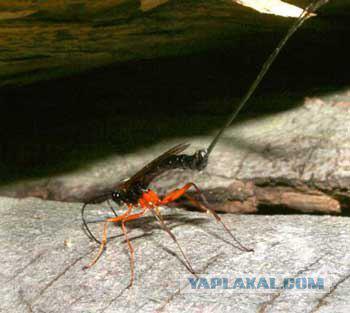
In this final assurance that "drill" was not just a tree, but in the body of the larvae, the rider gets the time of infection: at the end of the ovipositor have organs that can perceive the taste of what lays an egg. So the riders feel the taste of meat ovipositor. And not only the taste of the meat: the female puts on the victim host olfactory mark, lest the competition larvae within a single host. If after that another female ovipositor Me beetle larvae under the bark, after much agonizing minutes of drilling, she felt the tip of ovipositor special "taste" and take out the ovipositor, not postponing eggs: the place is busy. In one successful drilling with the female egg deferred Rhyssa persuasoria falls nine "dummy" bores.
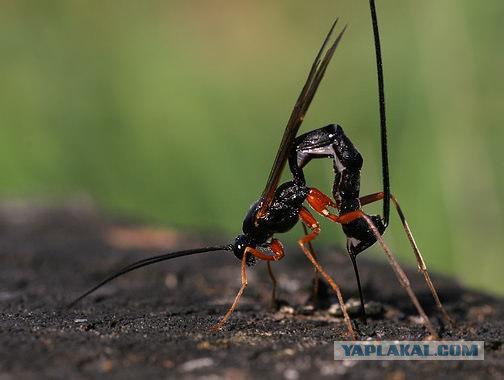
If the female does not replaces "tags" or neglect signal in the host body would be more larvae look like small worms, without legs and eyes. The whole world is a larva - the internal organs of its host, the larvae of the beetle. This world larva rider is fit, it "knows" what to do, where to crawl, in what order there. Usually young larvae begin to supply hemolymph, and only at the end of the internal organs are taken there.
The larvae feed on a definite plan for his victim inside - and suddenly these plans are violated, they have to compete with each other. Sometimes they fight, literally tearing each other to pieces mandibles. Sometimes the fight is held indirectly - the oldest larva eats all that she needed, and the rest will have to die in an empty pelt host. However, sometimes "small" is "removed": many parasites only the smallest larvae have sickle-shaped mandibles, older larvae are large, heavy, and they blunt jaws. So little older literally jammed - if they manage to find them in time, until we molted in "older form of" fat and not so aggressive. All these features of the competitive relationship is complicated biology in the body of the host may be the larvae of different kinds of riders, with some, say, the winter sleep, and the other is not - it is clear who is awake, and eat one another. Some larvae riders specially developed special body - the tail, he is to stop when traveling, and move them between host bodies with one goal - to find a competing larvae. No wonder those larvae that have tail, there are well-developed mandibles. On the external host can compete parasite sitting on top of the skin of the host, and the internal, in the depths of his body. Here there are plenty of options - one port to another food that causes choking, poison ...

Anyway, the rest of the larva eats the host riders and pupate, then takes off running from the wood of a young rider, ready to mate. Feed adult riders usually nectar and pollen, vegetable juice and sweet honeydew aphids. Distributed Ephialtes-obnaruzhivatel across the forest area of Europe and Siberia. Related Ephialtes riders of the genera and Rhyssa Megarhyssa parasitic larvae horntails, who also live in the trunks of trees.

The larvae of some species of riders are forced to look for food. But they do not have legs, and nature had to try a little, and the larvae of riders increased false legs - the so-called abdominal, they can be located anywhere: on the back or at the ends of the trunk. Thus different larvae move differently. Some, for example, fold in half, pull the front part of the body forward, and then begin to slide on the surface, like a real caterpillar; Other flipped on its back legs and fingers; If a bot put on the abdomen, it can not move, and certainly she rolled onto her back.
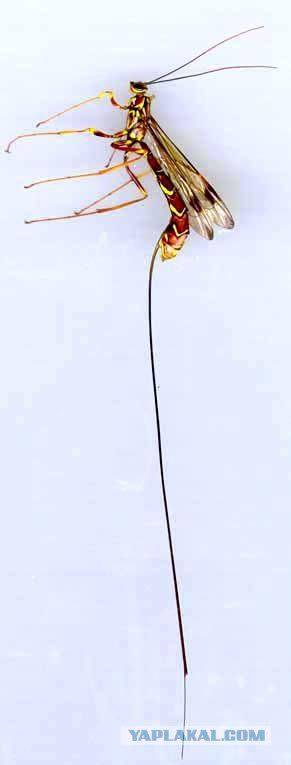
Some species of insects, but as animals in general, do not lay many eggs in order to increase the population and to then selected the strongest. Many of the emerging into the light die in the first days of his life. Nature would have it, to continue the race may be only the most trained individuals. Therefore, it is important not the number of eggs per clutch, and the conditions for the development of larvae and genetic information.
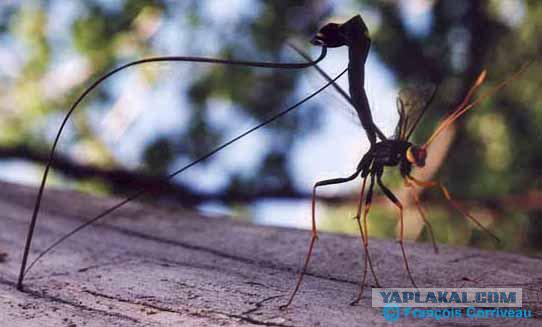
Interesting fact - the host and parasite live one life. And if a caterpillar it's time to lie down in hibernation, the larva and the rider falls asleep, and with the arrival of spring life will continue both at a pre-written script.
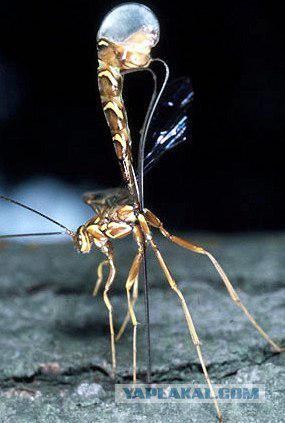
Blood-curdling images of larval development rider Cotesia glomerata, in vivo, inside the body of the caterpillar host. It is amazing: the virus, which infects the wasp caterpillar by cutting off her immune system, and controlling the behavior of the unfortunate - part of the genome of the rider, and is a descendant of the viral infection, has infected millions of years ago, the ancestors of Cotesia glomerata. When the time comes, the larvae pupate and are selected out. But the virus causes the caterpillar to continue its role: it covers the pupal larvae protective cocoon, and their bodyguard remains fiercely protecting babies sleep most recently gobbled up her insides in a strictly
4:43
On this Site ivanov-petrov.livejournal.com, naturearchive.ru, dirty.ru
Source:
This is about them and will be discussed.
Riders - the most primitive representatives of the higher group Hymenoptera, called "apocrita." Indeed, the first abdominal segments have narrowed, forming a constriction between the abdomen and chest. This structure increases the mobility of the abdomen of the insect. The rider can push the abdomen between the legs and put his head in front of the ovipositor. This device ensured the success of hunting riders and the following group Hymenoptera.

Riders are parasitic insects. Ephialtes-obnaruzhivatel quite large (up to 4 cm) rider with a black body and red feet, belongs to the family Ichneumonidae, which has more than 100,000 species. The word «ichneumon» in Greek means "hound", "the one who looks for prey on the trail," and also the name of a small Egyptian chanterelles, "Pharaoh's mouse", which was thought to have Egyptian Pharaohs used to hunt. And the name is very suitable riders, sharply delineating their differences from other types of hunters - ambush mantis or ferocious "tigers" -skakunov.
Ichneumonidae in character - treasure hunters. With a subtle sense of smell, they run on dry tree trunk, looking immured under the bark of larvae of insects - beetles, jewel beetles, longhorn beetles. Sometimes the rider flies the trunk of a spiral, looking for a place where they buried under a thick crust Zhuchin larva. How do they manage to sniff the larva through the thick crust - the mind boggles. Having found the place, the rider sits on the pine trunk and starts to poke through its ovipositor. Therefore, many Ichneumonidae the ovipositor are great length - some 7, 5 times longer than the body. It is the whole rig. True, Ephialtes ovipositor only slightly longer than the body. First, the rider pushes the box in which to store his equipment to one side, then rises "on tiptoes" and slowly screw the thinnest edge of the crust. This rider has to rotate screwing ovipositor deeper. Drilling operation can sometimes take a few hours. Thin ovipositor through its special unit easily passes through the thick bark and sticks into bated at a depth of several centimeters larva victim. Then, the egg passes ovipositor.

In this final assurance that "drill" was not just a tree, but in the body of the larvae, the rider gets the time of infection: at the end of the ovipositor have organs that can perceive the taste of what lays an egg. So the riders feel the taste of meat ovipositor. And not only the taste of the meat: the female puts on the victim host olfactory mark, lest the competition larvae within a single host. If after that another female ovipositor Me beetle larvae under the bark, after much agonizing minutes of drilling, she felt the tip of ovipositor special "taste" and take out the ovipositor, not postponing eggs: the place is busy. In one successful drilling with the female egg deferred Rhyssa persuasoria falls nine "dummy" bores.

If the female does not replaces "tags" or neglect signal in the host body would be more larvae look like small worms, without legs and eyes. The whole world is a larva - the internal organs of its host, the larvae of the beetle. This world larva rider is fit, it "knows" what to do, where to crawl, in what order there. Usually young larvae begin to supply hemolymph, and only at the end of the internal organs are taken there.
The larvae feed on a definite plan for his victim inside - and suddenly these plans are violated, they have to compete with each other. Sometimes they fight, literally tearing each other to pieces mandibles. Sometimes the fight is held indirectly - the oldest larva eats all that she needed, and the rest will have to die in an empty pelt host. However, sometimes "small" is "removed": many parasites only the smallest larvae have sickle-shaped mandibles, older larvae are large, heavy, and they blunt jaws. So little older literally jammed - if they manage to find them in time, until we molted in "older form of" fat and not so aggressive. All these features of the competitive relationship is complicated biology in the body of the host may be the larvae of different kinds of riders, with some, say, the winter sleep, and the other is not - it is clear who is awake, and eat one another. Some larvae riders specially developed special body - the tail, he is to stop when traveling, and move them between host bodies with one goal - to find a competing larvae. No wonder those larvae that have tail, there are well-developed mandibles. On the external host can compete parasite sitting on top of the skin of the host, and the internal, in the depths of his body. Here there are plenty of options - one port to another food that causes choking, poison ...

Anyway, the rest of the larva eats the host riders and pupate, then takes off running from the wood of a young rider, ready to mate. Feed adult riders usually nectar and pollen, vegetable juice and sweet honeydew aphids. Distributed Ephialtes-obnaruzhivatel across the forest area of Europe and Siberia. Related Ephialtes riders of the genera and Rhyssa Megarhyssa parasitic larvae horntails, who also live in the trunks of trees.

The larvae of some species of riders are forced to look for food. But they do not have legs, and nature had to try a little, and the larvae of riders increased false legs - the so-called abdominal, they can be located anywhere: on the back or at the ends of the trunk. Thus different larvae move differently. Some, for example, fold in half, pull the front part of the body forward, and then begin to slide on the surface, like a real caterpillar; Other flipped on its back legs and fingers; If a bot put on the abdomen, it can not move, and certainly she rolled onto her back.

Some species of insects, but as animals in general, do not lay many eggs in order to increase the population and to then selected the strongest. Many of the emerging into the light die in the first days of his life. Nature would have it, to continue the race may be only the most trained individuals. Therefore, it is important not the number of eggs per clutch, and the conditions for the development of larvae and genetic information.

Interesting fact - the host and parasite live one life. And if a caterpillar it's time to lie down in hibernation, the larva and the rider falls asleep, and with the arrival of spring life will continue both at a pre-written script.

Blood-curdling images of larval development rider Cotesia glomerata, in vivo, inside the body of the caterpillar host. It is amazing: the virus, which infects the wasp caterpillar by cutting off her immune system, and controlling the behavior of the unfortunate - part of the genome of the rider, and is a descendant of the viral infection, has infected millions of years ago, the ancestors of Cotesia glomerata. When the time comes, the larvae pupate and are selected out. But the virus causes the caterpillar to continue its role: it covers the pupal larvae protective cocoon, and their bodyguard remains fiercely protecting babies sleep most recently gobbled up her insides in a strictly
4:43
On this Site ivanov-petrov.livejournal.com, naturearchive.ru, dirty.ru
Source:
Tags
See also
Salvation kitten (3 pics + video)
Yesterday's tornado in Novorossiysk 19.08.2010 (4 pics + video)
One hundred ducks per shot (3 pics + video)
He departed from the hatch during an accident (4 pics + video)
The brutal showdown in Latvia (7 photos + video)
Head-on collision with a Gazelle (5 photo + video)
Japanese cat Maru (10 photos + video)
Miraculously survived (2 photos + video)
Santa rides in Krasnodar (6 photos + video)
Minibus with passengers crashed into a pole (4 pics + video)

















